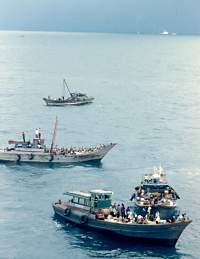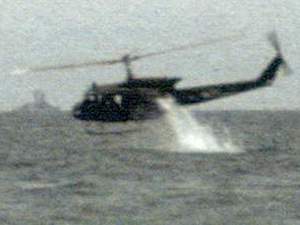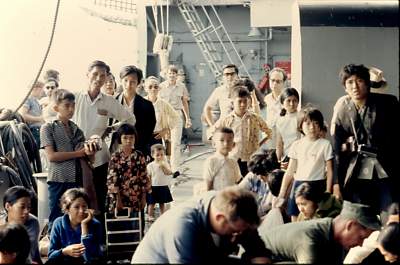
Veterans Month
November 2003
NS Veterans Remember
William F. Perdue
Senior systems coordinator
Financial Planning
Norfolk
Commander, United States Navy (Retired)
Join the Navy and see the world - how true! In 21 years of service, I captured many memories while traveling throughout the world. Watching the surreal glow of the Aurora Borealis from the frozen world of Arctic ice, or the splendor of sunrise viewed from the 13,000-ft summit of Fujiyama. Wandering through the exotic markets of Istanbul, or walking the sacred paths of the Holy Lands. Exploring the crumbling ruins of the Coliseum, or the eerily preserved homes of Pompeii. Hanging on through wild rides on 35-ft waves in an angry sea, or enjoying a quiet transit through the Panama Canal.
 Refugees from the fall of South Vietnam jam boats. |
There are other kinds of memories as well … such as launching waves of aircraft with a special delivery for Muammar Qaddafi. But no experience is more vividly burned into my memory than the events of the spring of 1975 - the evacuation of South Vietnam. Perhaps one of the greatest humanitarian efforts ever undertaken, the evacuation closed the book on our nation's Vietnam experience. For the under-40 crowd, Vietnam and the evacuation are merely words in history books, or perhaps images from some television documentary. For those of us who lived through it, nearly 30 years cannot dull the emotions of those days.
I was a young Ensign serving on board the USS Mobile (LKA 115). Mobile was an "attack" cargo ship of the amphibious fleet. Rather than big guns, she bristled with giant booms used to hoist her many landing craft and to fill her spacious cargo holds with the materials of war. April 1975 found us steaming at flank (top) speed to cross the vast expanse of the Pacific Ocean from Hawaii to Okinawa. South Vietnam's days were numbered, and we were ordered to help evacuate the remaining Americans and some 5,000 South Vietnamese citizens. Docking at White Beach, Okinawa, on April 17, we embarked Marines and began an immediate load out. Marines and sailors worked feverishly together through the night to load of tons rice and other supplies. We got underway for the South China Sea the next day and arrived off the coast of South Vietnam the evening of April 20. Along the distant shore, artillery fire and star shells bore visible witness to the raging battle.
It was an impressive armada. The gathering of over 40 ships, including four aircraft carriers, was the largest since D-Day. On board Mobile, we circled endlessly in our "Gator-box" - a two by three nautical mile patch of ocean 17 miles from Vung Tau at the mouth of the Saigon River. Our guns manned, no one knew what to expect or much less when. At that time, I was part of a plan to take our boats on the 65-mile run up the river to Saigon. (That would have been a "lively" transit!) However, it became apparent that the situation on the ground was deteriorating rapidly, and that plan was discarded as far to risky. The heat was stifling. The sun mercilessly heated the steel decks to temperatures well over 100 degrees. It was dead calm … the only breeze created by our 3-kt crawl. Nothing to do but wait, watch and be ready.
Nine days passed, and the wait was over on April 29 at 1:30 p.m. The evacuation, Operation Frequent Wind, officially began. Unaware of the chaos in Saigon, we would soon learn the depth of the crisis from those lucky enough to board amid a desperate crush of people scrambling to escape. Originally forecast at only a few thousand evacuees, the numbers would swell to tens of thousands before this final chapter was written.
They came in droves ... first by helicopter, later in anything that would float ... tiny fishing boats, rusting ships, and barges. They came abandoning everything ... homes, possessions and even families. They came as solders, doctors, businessmen, teachers, engineers, fishermen and simple farmers. They came to escape the tragedy of their war-ravaged nation. They came to build new lives, with the hope of experiencing what many of us fail to recognize as our nation's most precious possession - freedom.
But for now, it was just beginning. Searching the sky for our returning helicopters, we had our first encounter early - and from a totally unexpected source. About 2:30 p.m., a flight of four RVN Cobras suddenly appeared amidst our armada. Tension was high. They had been our allies, but were they friend or now foe? One of the helos headed straight for our flight deck. The flight deck officer frantically tried to wave him off, but to no avail. Short of shooting him down, we had no choice but to allow the bird to land. A jubilant South Vietnamese crew spilled out of the bird, clearly overjoyed at their escape from the hopeless battle raging ashore. But now we had a problem. Dozens of "Jolly Greens" were outbound from Saigon. We had to clear our deck for the incoming helos.
 A South Vietnamese helicopter pilot ditches his craft to make room for others on the Mobile. |
No one had planned for this unprecedented event. Before anyone could decide what to do, the pilot took action. In an act of unselfish bravery, he bounded back toward his helo and declared would fly it off deck - ditching in the ocean. As the Cobra rose and swung slowly to starboard, we scrambled to launch a rescue boat. A few hundred yards away and 10 feet off the water, the pilot jumped. The pilotless aircraft wobbled forward a few more yards shattering as the blades smacked the water. As the smoke and water cleared, no one could see how the pilot could have survived the explosion. Miraculously, he did. He was soon back on board - albeit in a stretcher this time - suffering only a couple of broken ribs from the concussion.
Our first "official" passengers arrived less than an hour later — a mix of embassy personnel, Vietnamese officials and 33 members of the Saigon press corps. The next 24 hours became a blur of images. Helicopters swarming through the air like mosquitoes, searching for clear decks to land on and discharge their human cargo. Our landing craft ferrying refugees to half a dozen chartered merchant ships. The flood of bewildered Vietnamese, their faces reflecting the pain and shock. Three more RVN Cobras landed on the Mobile. By now, the crew had adapted and devised a way to jettison the $500,000 Huey helicopters overboard. As they floated slowly away, they rolled and bobbed in the water like giant dead fish before finally disappearing below the waves.
In that first day, over 700 people stumbled down the ladders from the Mobile's flight deck. They endured weapons searches, medical screening, questioning and of course, paperwork. Finally, they were allowed to take refuge in a specially prepared cargo hold. The crew worked tirelessly to provide food, medical treatment, blankets and just human caring for our guests. Special latrines had been built. We built makeshift showers, privacy screens and did anything we could do to comfort and ease the pain of a displaced people.
 Refugees being processed. |
Their stories were unimaginable. Many families were wrenched apart. One arriving helo brought a four-year-old boy of mixed parentage (the father may have been an American solder). His mother had been unable to board the flight. In a desperate, heart-wrenching moment, she pinned a note to the child's shirt and thrust him on the helo. She knew his life would be full of misery in Vietnam. His parentage would make him an outcast. Aboard Mobile, marines and sailors were overcome by emotion when they read the note. It simply gave the child's name and said, "... Please take care of him."
One of the RVN Cobras created yet another moment of drama. Alighting on deck, the helo disgorged what seemed to be an impossible number of people from such a small aircraft. The pilot stumbled off, in obvious pain from a leg wound, but that was only a small part of his agony. He had been rushing to cram his family aboard when his wife ran to search for his mother. The North Vietnamese were pressing the battle close at hand when a bullet or shrapnel tore through the pilot's leg. In an act of desperation, he managed to get airborne, forced to abandon his wife and mother. Finding our deck less than an hour later, no one could restrain him from his desire to return and to rescue the remainder of his family. However, fate intervened. Weak from loss of blood, he collapsed three steps from his helo. Our medical team rushed him to sickbay for emergency treatment. The Cobra was jettisoned overboard, and the fate of his wife and mother unknown.
Day two brought new challenges. By now, we had moved out 70 miles from shore after a rumored sighting of a North Vietnamese gunboat. Somehow, 20 or so fishing boats managed to find us. The boats were overloaded, crammed with the first of a new flood of unexpected refugees. On his knees, a Vietnamese Roman Catholic priest prayed for us to take them aboard. It was gut wrenching. Under orders to take on people only from the helos, we had to ignore their pleas and turn them away. Later our orders would change and allow the rescue of all that came. But as we drifted apart, the images of anguish, desperation, and bewilderment visible in the faces of the men and women on those boats were forever etched into my memory.
More came. Then, still more. An estimated 71,000 Vietnamese abandoned their homes and escaped in hundreds of boats and other craft now mingling with the fleet. The scene was unimaginable. Our landing craft became shuttles - ferrying refugees from their rickety crafts to ships assigned to carry them to destinations still unknown. The horizon was dotted with plumes of smoke. As they were rescued, owners set their boats afire in a gesture of finality. There was no going back.
Occasionally, someone would leap into the water in a desperate attempt to swim to the nearest ship. Our boats were there to pluck him or her out. There were suicides too. Apparently hopeless and overwhelmed by events, some chose the final embrace of the sea. One young woman, clinging to the anchor of the vessel she had escaped on, waved off attempts by our crew to rescue her. To their horror, she suddenly released her grip and slipped beneath the waves.
Thursday dawned. Few, if any of the crew had slept in three days, and the drama was far from over. Yet another wave of people appeared. This time, the remnants of the Vietnamese Navy - a mix of river patrol boats, World War II class landing ships, and ancient destroyer escorts - steamed into view, packed to the gills with hundreds of people, their legs dangling over the sides. With the merchant charters jammed to capacity, little could be done but supply them with food and water. They set out that night for Subic Bay in the Philippines. Later, a more difficult challenge was presented by the appearance of a hardly seaworthy barge carrying 600 heavily armed South Vietnamese paratroopers. Marines from the Mobile were dispatched with the ticklish task of disarming the troops. Fortunately, things went smoothly as M-16s and grenade launchers were tossed into the sea. After a night of uncertainty, space was made on the already overcrowded merchants, and the solders were transferred.
It was now May 2nd. Operation Frequent Wind was over. Exhausted, the crew tried to relax and absorb the incredible events. The sun set as we steamed away from Vietnam for the last time. We had witnessed the death of a nation and flight of a people in unprecedented numbers. It was said that we rescued more than 120,000. It is impossible to pass through such events unchanged, although we probably never really realize how we much are affected. Only the memories, sometimes all too vivid, remain. Reflecting back, I am glad to have been there. We touched the lives of thousands and gave them hope - a chance to make a new home in a new land and most importantly, enjoy the blessings of liberty.